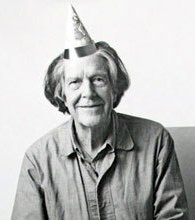What a difference 300 years makes. On evenings back-to-back,
the University of Cincinnati College-Conservatory of Music presented music from
the 17th and 20th centuries. It was as if one had set foot on two different
planets.
Wednesday evening (Nov. 28) in Corbett Auditorium, it was the CCM
choral series, with music by Claudio Monteverdi, a follow-up to their highly
successful performance of the composer’s Vespers of 1650 in 2010 (see review at http://www.musicincincinnati.com/site/reviews/Early_Music_Thriving_at_CCM.html ).

On Thursday (Nov. 29), also in Corbett Auditorium, the Percussion Group
Cincinnati, ensemble-in-residence at CCM, and the CCM Philharmonia Orchestra,
led by guest conductor Neal Gittleman, celebrated the 100th
anniversary of American composer John Cage with a program including his
“Renga” and “Music for Three" (the latter written for the Percussion Group
in 1984). It was the conclusion of a focus on Cage this fall at CCM and the 2012 installment of the Philharmonia's annual "American Voices" series.
The Percussion Group -- Allen Otte, James Culley and Russell Burge – was stationed at the far reaches of the stage with Culley and Birge in the back, Otte in the front, stage left. The Philharmonia, augmented to 123, including singers, readers, accordions and a laptop, performed 361 sketches by Henry David Thoreau of Walden Pond and its environs. Cage created the score by superimposing a time grid on Thoreau’s sketches and deriving parts for the orchestra from them. Otte, Culley and Burge performed 50 instruments each, adding up to quite a din overall, with Gittleman calling time at regular intervals.
Cage’s premise for “Renga” (the title refers to a type of Japanese poetry similar to a haiku) is an aesthetic one: structuring sound in its manifest variety to make a statement about life and the world, here a presumably American one, drawn from Thoreau’s observations at Walden Pond. This listener, however, would have appreciated being able to get a better sense of “Music for Three,” without the overweening presence of “Renga.” As it was, a gesture, a flourish, even a powerful statement from one of the three percussion stations would emerge without a feeling of how it all fit together. And at 30-minutes” duration, it simply went on too long. (Reception of the joint presentation was, in fact, tepid, with scant applause by the audience.)
Also on the program were Charles Ives’ “Three Places in New England” and the Piano Concerto by Lou Harrison (1917-2003) with soloist Kris Rucinski. Not on the program, but announced in advance, was Cage’s famous 4’33” (four minutes and 33 seconds during which the performer sits at the piano and plays nothing, the ambient noise in the room comprising the content of the work). One wonders why, but perhaps “Renga” with “Music for Three” was enough challenge for one concert.
By far, the signal event of the evening was Harrison’s Concerto, composed in 1985 for Keith Jarrett. In four movements, scored for piano, strings, percussion, two harps and trombones, it is a gorgeous work with a dramatic, sweeping first movement (Allegro).* The second movement, marked “Stampede” (the reference is to a medieval dance called the “estampie”), had Rucinski rushing pell mell over the keys, often striking them with his elbow, or with a wooden bar, allowing him to depress clusters of octaves. Accompanying him were numerous percussion, including bongos, sleigh bells, maracas and bass drum.
The Largo was a beauty, hymn-like in expression, with a stirring climax and a soft-breathed conclusion. The brief final movement was perpetual motion, with pealing piano figures underpinned by cellos, basses and trombones. Gittleman led a splendid performance by the Philharmonia, and the entire Concerto was a tour de force for Rucinski, who obliged the audience with CCM composer Rachel Walker’s “Night Music,” a soft, spare effusion, ending with a widely-spaced interval.
The concert opened with Ives’ “Three Places in New England,” always a delight for its American allusions (hymns, spirituals, marches, you name it) and bracing harmonies. The Philharmonia, nearly 100-strong, with a robust string sound, showed itself to be a well-trained, formidable ensemble under Gittleman’s baton. Balances were well-crafted, with brassy marches in “Putnam’s Camp, Redding, Connecticut” and spooky atmospherics in “The Housatonic at Stockbridge.”
The concert was enhanced by images projected onto a screen above the stage by Len Gittleman for Cage’s “Renga” and by Gittleman and Richard Nilsen for the Ives.
*The unusual scoring is to facilitate Kirnberger II temperament, a “just” intonation system specified by Harrison as a means of achieving perfect intervals on the piano (a fixed-pitch instrument) by tweaking the tuning here and there. Accordingly, the strings tuned their open strings to the piano, and the harps were tuned to the piano. No adjustments are necessary for trombones (naturally flexible in pitch) and none for the unpitched percussion.